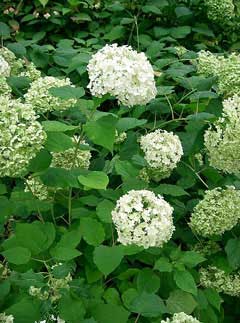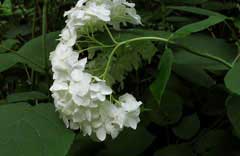 |
|
http://commons.wikimedia.org/wiki/User:KENPEI |
 |
| http://www.inmygarden.org/ |
Translate this page:
Summary
Bloom Color: Blue, Lavender, Pink, Red, White. Main Bloom Time: Early summer, Early fall, Late summer, Late spring, Mid summer. Form: Rounded, Spreading or horizontal.
Physical Characteristics

 Hydrangea arborescens is a deciduous Shrub growing to 3 m (9ft) by 2 m (6ft) at a medium rate.
Hydrangea arborescens is a deciduous Shrub growing to 3 m (9ft) by 2 m (6ft) at a medium rate.
See above for USDA hardiness. It is hardy to UK zone 3 and is not frost tender. It is in flower from July to August. The species is hermaphrodite (has both male and female organs) and is pollinated by Bees.
It is noted for attracting wildlife.
Suitable for: light (sandy), medium (loamy) and heavy (clay) soils and prefers well-drained soil. Suitable pH: mildly acid, neutral and basic (mildly alkaline) soils and can grow in very acid soils.
It can grow in semi-shade (light woodland) or no shade. It prefers moist soil.
UK Hardiness Map
US Hardiness Map
Synonyms
Hydrangea vulgaris
Plant Habitats
Woodland Garden Sunny Edge; Dappled Shade; Shady Edge;
Edible Uses
Edible Parts: Stem
Edible Uses:
The peeled branches and twigs have been used to make a tea[257]. The new growth of young twigs has been peeled, boiled thoroughly then fried and eaten[257].
References More on Edible Uses
Medicinal Uses
Plants For A Future can not take any responsibility for any adverse effects from the use of plants. Always seek advice from a professional before using a plant medicinally.
Anthelmintic Cathartic Diaphoretic Diuretic Sialagogue Tonic
Seven barks was used by the North American Indians as a remedy for kidney and bladder stones and is still used for these purposes in modern herbalism[254]. It is considered to both encourage the expulsion of stones and to help dissolve those that remain[254]. The roots are anthelmintic, cathartic, diaphoretic, diuretic, emetic and tonic[4, 21, 46, 165, 222, 238]. They are used in the treatment of kidney stones, mucous irritations of the bladder, cystitis, nephritis, enlarged prostate and bronchial afflictions[222, 238, 254]. Excessive doses can cause dizziness and bronchial congestion[238]. The fresh roots are very succulent and can be easily cut, when dry they become very tough and resistant[4]. They are harvested in the autumn and it is best to cut them into short sections before drying them[4, 254]. The scraped bark is used as a poultice on wounds, burns, sore muscles, sprains etc[222]. The bark is chewed in the treatment of stomach and heart ailments[222]. The leaves are cathartic, diuretic, sialagogue and tonic[4].
References More on Medicinal Uses
The Bookshop: Edible Plant Books
Our Latest books on Perennial Plants For Food Forests and Permaculture Gardens in paperback or digital formats.

Edible Tropical Plants
Food Forest Plants for Hotter Conditions: 250+ Plants For Tropical Food Forests & Permaculture Gardens.
More

Edible Temperate Plants
Plants for Your Food Forest: 500 Plants for Temperate Food Forests & Permaculture Gardens.
More

More Books
PFAF have eight books available in paperback and digital formats. Browse the shop for more information.
Shop Now
Other Uses
References More on Other Uses
Cultivation details
Landscape Uses:Border, Foundation, Massing, Specimen. Tolerates most soils[200], thriving in a well-drained loamy soil[1], but resenting dryness at the roots[11, 200]. Requires partial shade[11]. Does well on very acid soils with a pH around 4.5[200]. In frosty areas it is best to site the plant in a position shaded from the early morning sun[238]. A good bee plant[108]. The flowers are sweetly scented[245]. Plants are best left unpruned[49]. Another report says that the previous year's flowering shoots should be cut back in early spring[238]. This species is notably susceptible to honey fungus[200]. Special Features:North American native, Suitable for cut flowers, Suitable for dried flowers, Blooms are very showy.
References Carbon Farming Information and Carbon Sequestration Information
Temperature Converter
Type a value in the Celsius field to convert the value to Fahrenheit:
Fahrenheit:
The PFAF Bookshop
Plants For A Future have a number of books available in paperback and digital form. Book titles include Edible Plants, Edible Perennials, Edible Trees,Edible Shrubs, Woodland Gardening, and Temperate Food Forest Plants. Our new book is Food Forest Plants For Hotter Conditions (Tropical and Sub-Tropical).
Shop Now
Plant Propagation
Seed - surface sow in a greenhouse in spring[113]. Cover the pot with paper until the seed germinates[78]. When they are large enough to handle, prick the seedlings out into individual pots and grow them on in the greenhouse for at least their first winter. Plant them out into their permanent positions in late spring or early summer, after the last expected frosts. Cuttings of half-ripe wood, 8cm long, July/August in a frame. Overwinter in a greenhouse and plant out in late spring[78]. Thick growths make the best cuttings, but these should be placed in individual pots[78]. Good percentage[113]. Cuttings of mature wood in late autumn in a frame[200]. Mound layering in spring. Takes 12 months[78]. Division of suckers in late winter[113]. They can be planted out direct into their permanent positions. Leaf-bud cuttings of the current seasons growth in a frame[200].
Other Names
If available other names are mentioned here
Native Range
NORTHERN AMERICA: United States (Indiana, New Jersey, New York (south), Ohio, Pennsylvania, West Virginia, Illinois, Kansas (Cherokee Co.), Missouri, Oklahoma, Alabama, Arkansas, Delaware, Florida, Georgia, Kentucky, Louisiana, Maryland, Mississippi (east), North Carolina, South Carolina, Tennessee, Virginia, District of Columbia)
Weed Potential
Right plant wrong place. We are currently updating this section.
Please note that a plant may be invasive in one area but may not in your area so it's worth checking.
Conservation Status
IUCN Red List of Threatened Plants Status :

| Related Plants
|
| Latin Name | Common Name | Habit | Height | Hardiness | Growth | Soil | Shade | Moisture | Edible | Medicinal | Other |
| Clerodendrum bungei | Glory Flower, Rose glorybower, Cashmere Bouquet, Mexican Hydrangea, Glory Bower | Shrub | 2.0 |
7-9
| M | LMH | N | M | 0 | 1 | 0 |
| Deinanthe bifida | | Perennial | 0.4 |
6-9
| S | LM | FS | M | 1 | 0 | |
| Deutzia scabra | Fuzzy pride-of-rochester, Deutzia | Shrub | 3.0 |
5-8
| M | LMH | SN | M | 1 | 0 | 2 |
| Dichroa febrifuga | Chinese Quinine, Dichroa | Shrub | 2.0 |
8-11
| M | LMH | SN | M | 0 | 3 | 1 |
| Hydrangea anomala | Hydrangea | Climber | 12.0 |
4-8
| F | LMH | FSN | M | 3 | 1 | 3 |
| Hydrangea aspera | Hydrangea | Shrub | 4.0 |
7-9
| M | LMH | SN | DM | 1 | 0 | |
| Hydrangea hirta | | Shrub | 1.0 |
6-9
| | LMH | SN | M | 1 | 0 | |
| Hydrangea macrophylla | French hydrangea , Florist's Hydrangea, Bigleaf Hydrangea | Shrub | 3.0 |
5-9
| M | LMH | SN | M | 3 | 2 | 3 |
| Hydrangea paniculata | Panicled hydrangea, Hybrid Hydrangea, PeeGee Hydrangea, Panicle Hydrangea | Shrub | 4.0 |
3-8
| F | LMH | SN | MWe | 1 | 2 | 2 |
| Hydrangea serrata | Hydrangea, Mountain Hydrangea, Sawtooth Hydrangea | Shrub | 2.0 |
5-9
| M | LMH | SN | M | 2 | 0 | 3 |
| Hydrangea serrata amagiana | | Shrub | 2.0 |
5-9
| | LMH | SN | M | 4 | 0 | 2 |
| Hydrangea serrata thunbergii | Tea of heaven, Ama-tsja, | Shrub | 1.5 |
5-9
| | LMH | SN | M | 3 | 0 | 2 |
| Philadelphus coronarius | Mock Orange, Sweet mock orange | Shrub | 4.0 |
4-8
| F | LMH | SN | M | 0 | 0 | 1 |
| Philadelphus delavayi | | Shrub | 4.0 |
5-9
| | LMH | SN | M | 0 | 0 | 1 |
| Philadelphus lewisii | Mock Orange, Lewis' mock orange | Shrub | 3.6 |
4-8
| | LMH | SN | M | 0 | 1 | 3 |
| Philadelphus microphyllus | Littleleaf Mock Orange | Shrub | 1.2 |
5-9
| | LMH | SN | DM | 1 | 0 | 1 |
| Philadelphus pubescens | Hoary mock orange | Shrub | 5.0 |
5-9
| | LMH | SN | M | 0 | 0 | 1 |
| Philadelphus purpurascens | | Shrub | 4.0 |
5-9
| | LMH | SN | DM | 0 | 0 | 1 |
| Philadelphus x virginalis | Mock Orange | Shrub | 3.0 |
5-8
| M | LMH | SN | M | 0 | 0 | 1 |
| Platycrater arguta | | Shrub | 1.0 |
7-10
| | LMH | S | M | 1 | 0 | 3 |
| Schizophragma hydrangeoides | Japanese Hydrangea Vine | Climber | 12.0 |
5-8
| S | LMH | FSN | M | 1 | 0 | 3 |
| Schizophragma integrifolium | | Climber | 12.0 |
6-9
| | LMH | FSN | M | 0 | 2 | 3 |
|
Growth: S = slow M = medium F = fast. Soil: L = light (sandy) M = medium H = heavy (clay). pH: A = acid N = neutral B = basic (alkaline). Shade: F = full shade S = semi-shade N = no shade. Moisture: D = dry M = Moist We = wet Wa = water.
Now available:
Food Forest Plants for Mediterranean Conditions
350+ Perennial Plants For Mediterranean and Drier Food Forests and Permaculture Gardens.
[Paperback and eBook]
This is the third in Plants For A Future's series of plant guides for food forests tailored to
specific climate zones. Following volumes on temperate and tropical ecosystems, this book focuses
on species suited to Mediterranean conditions—regions with hot, dry summers and cool, wet winters,
often facing the added challenge of climate change.
Read More
Expert comment
Author
L.
Botanical References
1143200
Links / References
For a list of references used on this page please go here
Readers comment
© 2010, Plants For A Future. Plants For A Future is a charitable company limited by guarantee, registered in England and Wales. Charity No. 1057719, Company No. 3204567.